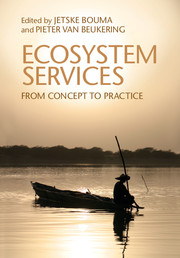Book contents
- Frontmatter
- Contents
- About the authors
- Part I Introduction
- Part II Measuring ecosystem services
- Part III Valuing ecosystem services
- Part IV Paying for ecosystem services
- Part V Governing ecosystem services
- 10 Global governance of ecosystem services and related policy instruments
- 11 Public–private partnerships and the governance of ecosystem services
- 12 Local governance of ecosystems and community co-management
- Index
- Plate section
- References
12 - Local governance of ecosystems and community co-management
from Part V - Governing ecosystem services
Published online by Cambridge University Press: 05 February 2015
- Frontmatter
- Contents
- About the authors
- Part I Introduction
- Part II Measuring ecosystem services
- Part III Valuing ecosystem services
- Part IV Paying for ecosystem services
- Part V Governing ecosystem services
- 10 Global governance of ecosystem services and related policy instruments
- 11 Public–private partnerships and the governance of ecosystem services
- 12 Local governance of ecosystems and community co-management
- Index
- Plate section
- References
Summary
Introduction
The popularity of local governance approaches in ecosystem management has increased over the last decades. There seem to be several reasons for why this has been the case. First, top-down approaches to ecosystem governance have not been very cost-effective as the costs of top-down enforcement of resource-use restrictions have been relatively high (Somanathan et al., 2009). This has been the case in water management, fisheries management, forest management, wetland management, nature conservation, etc. Also, especially in conservation-oriented approaches, the livelihood costs of prohibiting resource use, and sometimes even displacement of local communities, have been enormous (Cernea and Schmidt-Soltau, 2006). As a result, conservation agencies and governments have started exploring alternative approaches to ecosystem governance like integrated conservation–development approaches and community co-management in order to reduce adverse livelihood impacts, increase local participation, and reduce monitoring and enforcement costs. Second, an understanding has been emerging that ecosystems do not necessarily need to be managed by governments solely but that local communities can self-govern common-good resources effectively as well. Ostrom (1990) showed that communities can sustainably manage forests, pastures, wetlands, and other common-good resources, and that collective resource rights do not need to result in a “tragedy of the commons” if local governance mechanisms exist. This understanding, in combination with the finding that top-down governance of ecosystems has often not been very effective, has resulted in a decentralization of common-good resource management worldwide. Third, the human right to self-determination has become an important argument for local ecosystem governance, especially since people living in biodiversity-rich spots are often marginalized: not only are poverty and biodiversity strongly correlated, biodiversity hotspots coincide with indigenous peoples’ territories, indigenous peoples that are often not well represented in decision-making processes concerning their livelihoods (Colchester, 2004).
- Type
- Chapter
- Information
- Ecosystem ServicesFrom Concept to Practice, pp. 250 - 263Publisher: Cambridge University PressPrint publication year: 2015
References
- 1
- Cited by



